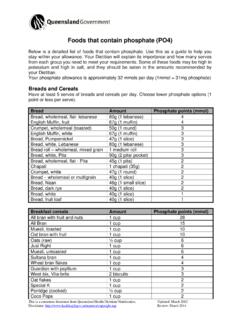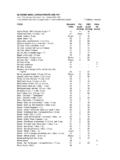Transcription of BIOLOGY OF PLANTS - MBGnet
1 BIOLOGY OF PLANTSHOW PLANTS live IN different PLACES :1. 3 large drawings ofthermometers2. 1 very large raindrop cut-out3. 1 very small raindrop cut-out4. 3 large sun cut-outs( place screen or cellophane over one of them)5. Pictures of desert scenery6. Pictures of tropical rainforest scenery7. Pictures or examples ofdesert plants8. Pictures or examples oftropical rain forest plantsWHERE DO I BELONG?Students classify pictures of habitats as deserts, tropical rain forests, or other different habitats, especially the desert and tropicalrain forest habitats*. Help students identify desert with ahot, dry, sunny place . Help students identify tropical rainforest as a warm, wet, shady the area you cut-outs and drawings for each habitat:Desert: Sun, thermometer with very high temperature,small raindropTropical Rain Forest: Sun with screen, thermometerwith warm temperature, large raindropYour Habitat: Sun (screened, covered, or full),thermometer (both hot and cold, if you have seasons),raindrop of appropriate very young children: Provide children with pictures oflocal, desert, and tropical rain forest habitats and students to separate them by the the places they comefrom.
2 Create a bulletin board panel for each older children: Ask the students to bring in or cut outpictures of the three habitat and plant types. Identify thelocation of each. Create a collage for one of the habitats.* Other habitats, such as grasslands or tundra, may also be OF PLANTSHOW PLANTS live IN different PLACES (for each group):1. Two living PLANTS of thesame type (using Pothosor Dracaena is best).2. Silk/plastic plant similarto living PLANTS (put in potwith soil)3. Plastic bags (producebags may work well)4. Rubber bands or longtwist ties5. Petroleum jellyWATER OUTS tudents will observe water loss through leaves (transpiration).Procedure:1. Discuss how PLANTS get water. Ask if any of the students might knowhow PLANTS lose water. Remind students that carbon dioxide goesinto PLANTS through holes in the leaf surface. PLANTS also give offoxygen through these same holes. If the idea is not suggested, askthe students if water might evaporate from the leaves through thesame Give each group their 2 living PLANTS and 1 silk/plastic Have students put petroleum jelly on the bottom of all of the leaveson one of their living PLANTS (this will cover most of the stomates).
3 Have the students water all three PLANTS well--but do not make the soilsopping wet. Cover each of the PLANTS with a plastic bag. Secureitto the base of the stem, or the pot, with rubber bands or long twist Observe all three PLANTS in 2 3 days. What has happened? Askwhere the water Make a chart to show results:The silk plant has no roots to carry water to leaves--its soil will bevery damp. The plant with no jelly on its leaves should have droplets oftranspired water on the inside of the bag. The plant with jelly on itsleaves should have no water on bag, but soil may be drier than theartificial Discuss with students how the water got on the bag. How did itcome out of the plant? Point out that the one with jelly came outdifferently. What does that suggest?9. Extension: Coat the bottom of several leaves with fingernail dry, peel this off and look at underside of leaf with a handlens or microscope to see the holes (stomates) where water andgases are lost.
4 Compare to a leaf that has not been coated with plant without jellyLiving PLANTS with jellyArtificial plantWater on bag (Y/N) Soil (wet/dry) BIOLOGY OF PLANTSHOW PLANTS live IN different PLACES (for each group):1. 3 sponges (4 x 3 x 11/16)2. 1 sponge (4 x 3 x 1 )3. 1 plastic bag4. 2 dishes large enough tohold sponges5. 2 measuring cups orgraduated cylinders6. WaterWATER LOSS AND LEAF STRUCTURES tudents will explore the roles of succulence and tough outer coverings in preventing water will infer that leaves like these help PLANTS survive in dry for Succulence:1. Give each group one large and one small sponge. Have themput each sponge in a dish. Have students pour equal amountsof water over each sponge. Allow the sponges to sit in thewater for a minute or students squeeze the thin sponge into a cup. How muchdid it hold? Repeat with the thicker sponge. Put the measuringcups next to each other. Which one has more water? (Olderchildren can subtract to measure how much more the thicksponge holds.)
5 Which sponge will dry out faster?3. Remind the class that some PLANTS live in places with lots ofwater, while others live in places with very little would thick leaves be better? Thin leaves? Why?Thick leaves like thick sponges can hold a large amount ofwater. In places where rain falls infrequently, PLANTS withthick, sponge-like succulent leaves survive the for Leaf Coverings:1. Give each group two thin dry sponges . place each in a 250 mL of water over each sponge. Allow the spongesto sit in the water for a minute or Have students carefully place one sponge in a plastic Now squeeze each sponge over measuring cups. Comparethe amount of water which comes Which is a better way to keep water in the sponge? In thisdemonstration, the bag acts like a tough waxy outer coating on aleaf, keeping moisture inside. Discuss the role of leaf shape andcovering in keeping PLANTS from loosing water in dry OF PLANTSHOW PLANTS live IN different PLACES :1.
6 Leaf patterns (next page)2. Scissors3. Construction paper4. Wax paper5. Water misterWATER LOSS AND LEAF SHAPES tudents will observe that leaf shape and coating can increase runoff of extra water. Students willinfer that leaves which shed water quickly keep PLANTS healthy in very damp with class about the shapes of leaves they see aroundtheir school and home. (You might have them bring insamples.) Is the shape of a leaf important? Discuss reasonsleaf shape may or may not be important for the survival ofthe plant. Suggest that they can find out by an the leaf patterns on the following pages so yourstudents can use each group of students cut out a set of patterns inboth construction and waxed paper. (You may also havethem use some large leaves found in your area as patterns.) students work first with the construction paper each with water and observe which one sheds waterbest. Compare results. (The heart-shaped drip-tip, pleatedfan-shape, fern, and split-shaped leaves should do the best.)
7 With wax paper leaves to compare with theconstruction paper ones. (The waxed coating should helpleaves shed water.) the students how leaves that shed water well mighthelp PLANTS in wet places survive? (Leaves which shedwater and dry quickly would be less likely to mold ormildew or be settled by small PLANTS .)Note: As we have seen in this activity and the previous one,waxy coatings can be beneficial for both desert and rain forestplants. In the desert, a waxy coating keeps moisture in the plant;in the rain forest, a waxy coating repels moisture which wouldotherwise damage the OF PLANTSHOW PLANTS live IN different PLACES LOSS AND LEAF SHAPE CONTINUEDLEAF PATTERNSS plit Leaf(Cut out holes)Large Round LeafFan-shaped Palm(Cut out and pleatalong the dotted lines)Drip-tip LeafFern(Fold paper inhalf and cut onthe fold for atwo-sided fern)










